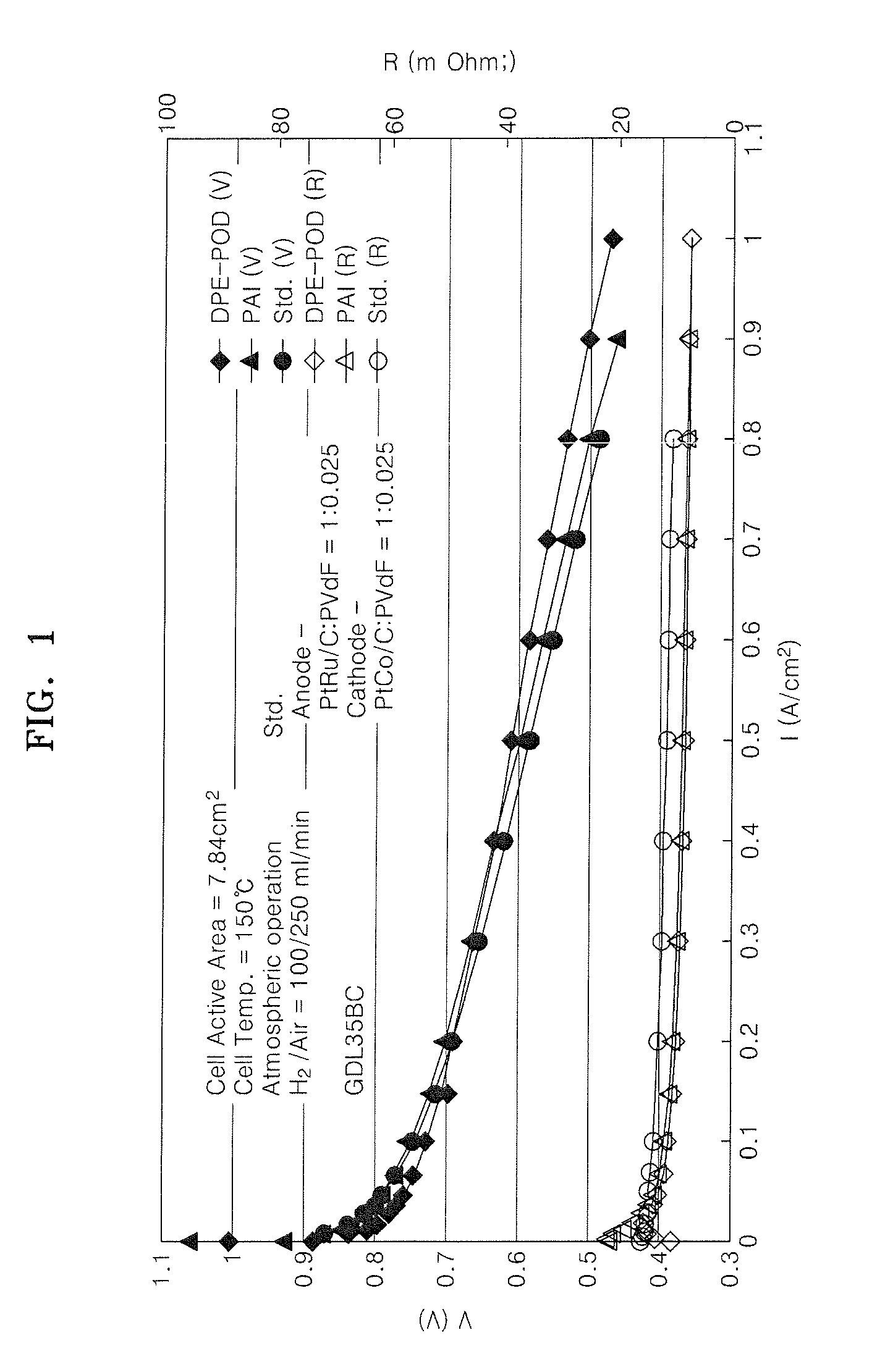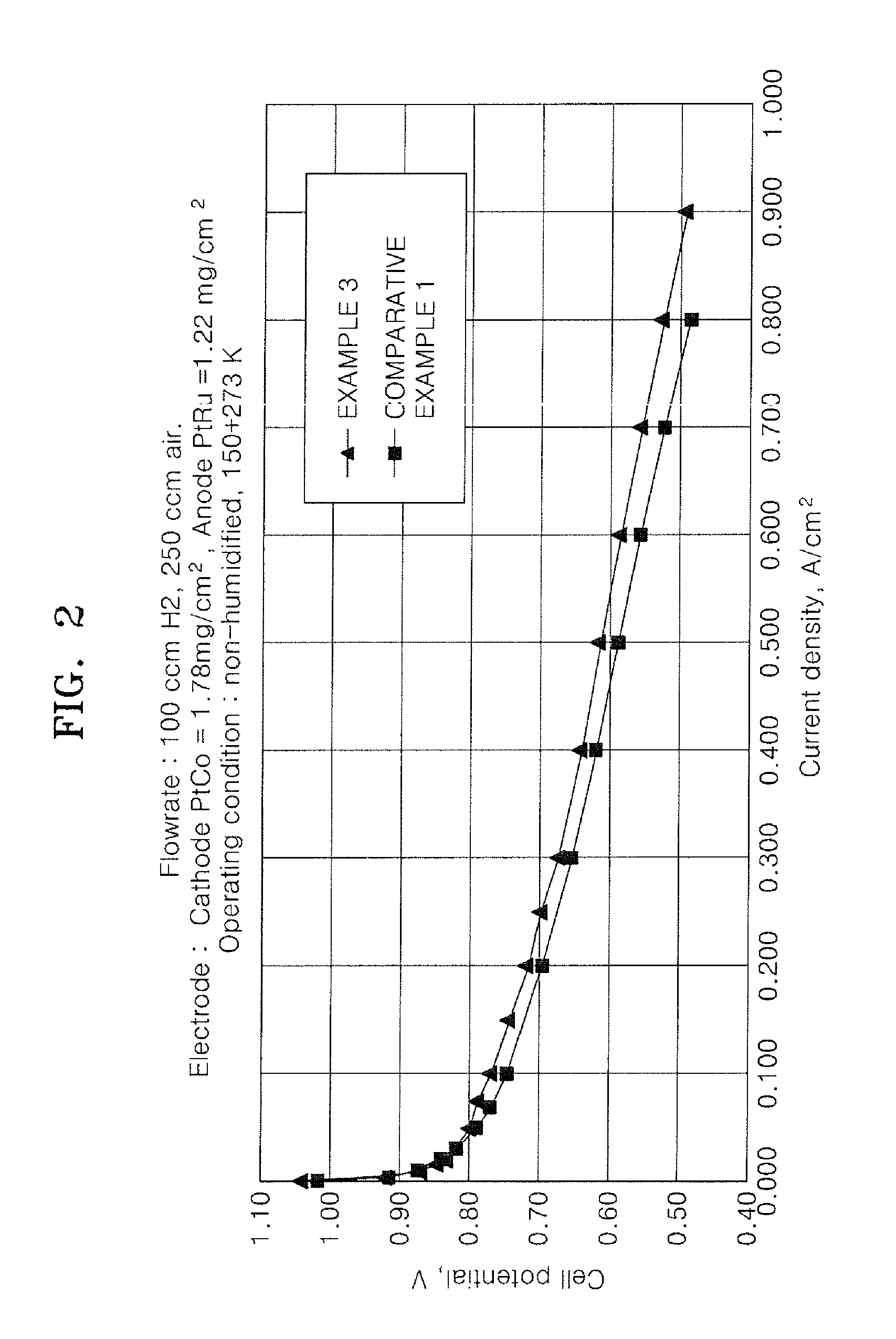Binder for electrode of fuel cell, electrode for fuel cell including the binder, method of manufacturing the electrode, and fuel cell using the electrode
a fuel cell and binder technology, applied in the direction of cell components, final product manufacturing, sustainable manufacturing/processing, etc., can solve the problems of electrode damage, insufficient phosphoric acid distribution, and insufficient fluidity control, so as to improve phosphoric acid retention capacity, improve wetting velocity, and minimize the effect of electrode structural changes
- Summary
- Abstract
- Description
- Claims
- Application Information
AI Technical Summary
Benefits of technology
Problems solved by technology
Method used
Image
Examples
synthesis example 1
Synthesis of the DPE-POD Represented by Formula 3
[0055]180 g of polyphosphoric acid, 30 g (0.08 mole) of diphenyletherdicarboxylic acid and 12 g (0.09 mole) of hydrazine sulfate were added to a four neck round bottomed flask under a nitrogen atmosphere, and the flask was heated to 100° C. Then, the flask was heated to 175° C., and stirred for 18 hours.
[0056]The mixture was precipitated in distilled water and neutralized with an NaOH aqueous solution. The resulting polymer was dried at 80° C. for 24 hours and dried at 60° C. in an oven in a vacuum to prepare the DPE-POD represented by Formula 3.
[0057]The structure of the DPE-POD of Formula 3 was confirmed by nuclear magnetic resonance (NMR) spectroscopy.
synthesis example 2
Synthesis of the HF-POD Represented by Formula 4
[0058]180 g of polyphosphoric acid, 30 g (0.08 mole) of diphenylhexafluoroisopropylidene dicarboxylic acid and 12 g (0.09 mole) of hydrazine sulfate were added to a four neck round bottomed flask under a nitrogen atmosphere, and the flask was heated to 100° C. Then, the flask was heated to 175° C., and stirred for 18 hours.
[0059]The mixture was precipitated in distilled water and neutralized with an NaOH aqueous solution. The resulting polymer was dried at 80° C. for 24 hours and dried at 60° C. in an oven in a vacuum to prepare the HF-POD represented by Formula 4.
[0060]The structure of the HF-POD of Formula 4 was confirmed by NMR spectroscopy.
example 1
[0061]1.0 g of PtCo / C, 0.03 g of the DPE-POD represented by Formula 3, 3.5 g of NMP as a solvent were mixed at room temperature and stirred for 5 minutes to prepare a slurry to be used to form a cathode catalyst layer.
[0062]The slurry to be used to form the cathode catalyst layer was coated onto carbon paper as a carbon support using a coating bar, and the coated slurry was dried at 80° C. for 1 hour, at 120° C. for 30 minutes, and at 150° C. for 10 minutes to prepare a cathode.
[0063]1.0 g of PtRu / C, 0.012 g of the DPE-POD represented by Formula 3, 0.018 g of polyvinylidene fluoride and 3.5 g of NMP as a solvent were mixed and stirred at room temperature for 5 minutes to prepare a slurry to be used to form an anode catalyst layer.
[0064]The slurry to be used to form the anode catalyst layer was coated on carbon paper as a carbon support using a coating bar, and the coated slurry was dried at 80° C. for 1 hour, at 120° C. for 30 minutes, and at 150° C. for 10 minutes to prepare an ano...
PUM
| Property | Measurement | Unit |
|---|---|---|
| temperature | aaaaa | aaaaa |
| proton conductivity | aaaaa | aaaaa |
| temperature | aaaaa | aaaaa |
Abstract
Description
Claims
Application Information
 Login to View More
Login to View More - R&D
- Intellectual Property
- Life Sciences
- Materials
- Tech Scout
- Unparalleled Data Quality
- Higher Quality Content
- 60% Fewer Hallucinations
Browse by: Latest US Patents, China's latest patents, Technical Efficacy Thesaurus, Application Domain, Technology Topic, Popular Technical Reports.
© 2025 PatSnap. All rights reserved.Legal|Privacy policy|Modern Slavery Act Transparency Statement|Sitemap|About US| Contact US: help@patsnap.com



